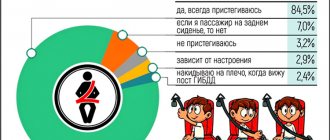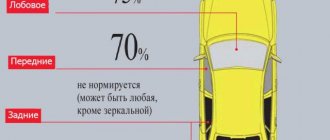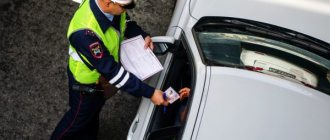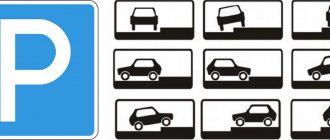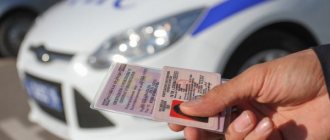The government is trying in every way to alleviate the unpleasant situation on the roads, applying stricter requirements for the technical condition of vehicles, making it more difficult to obtain a driver's license.
The main policy of the legislator is aimed at increasing the amount of financial liability for traffic offenses. Moreover, these kinds of changes affected almost all fines for violations, including those for an unbelted child.
Fines. Violation of the rules for transporting children will result in a fine. Driver - 3000 rubles. To the bus owner or carrier - 100,000 rubles. This is stated in paragraph 3 of Art. 12.23 Code of Administrative Offences.
If the driver violated the rules at night, the amount will be different: for the driver - 5,000 rubles, for the carrier - 200,000 rubles. Night time by law is from 23:00 to 6:00. The driver may also be deprived of his license for six months.
Background
The first fine for not having a car seat for a child, 500 rubles, was introduced in 2007. Since that time, it has increased several times, and by 2021 it amounted to 3,000 rubles. up to 100,000 rubles, depending on a number of accompanying circumstances.
Standards for the safe passage of children in vehicles were prescribed in the traffic rules back in 1993. According to them, the possibility of transporting a child in the back or front seat of a car was regulated. They established criteria under which standard seat belts could be used, or whether additional means were required.
How to challenge a fine
In case traffic rules are nevertheless violated and the inspector issues a fine, you need to know how the protocol is drawn up correctly and how to challenge it in case of disagreement.
If an employee exceeds his authority or disagrees with the fine imposed, you can write a complaint.
A sample complaint looks something like this:
To (the head of the State Traffic Safety Inspectorate of the Internal Affairs Directorate for (region, district))
from whom (full name, address, telephone)
COMPLAINT about leaving a protocol on a case of administrative violation
The date and time of the administrative violation, full name, and position of the inspector are described here. The details of the violation are also described. Facts indicating the unfoundedness of administrative punishment, etc.
The complaint must be accompanied by copies of all documents proving the rights of the plaintiff, if necessary, a petition and other available data (diagrams, photographs, videos, etc.).
In conclusion, it is worth saying that violating traffic rules is always unsafe and punishable, as it can create an emergency situation and lead to dire consequences. Despite the relatively small amount of administrative penalties for missing seat belts, you should never neglect them. Seat belts can not only protect against injury, but also save the life of the driver and all passengers in various types of accidents. In addition, repeated violations can lead to the loss of your driver's license.
pravo-auto.com
Rules for the safe passage of children in motor vehicles
Rules for the passage of children in motor vehicles place full responsibility for their observance on adults. According to them, there are separate standards for transporting a child in the rear or front car seat.
Children can ride in the front seat of a car if the following conditions are met:
- if a child is over twelve years old, weighs 36 kg or more, and is at least 150 cm tall, he can ride in the front seat of a car, fastened with regular car seat belts;
- If a child is under twelve years old, weighs less than 36 kg, and is not 150 cm tall, he can ride in the front using assistive safety devices (car seats and their equivalents).
Safe passage of children in the back seat of a car requires the following conditions:
- if the child is twelve years old, his weight and height have reached the required parameters (150 cm, 36 kg), he can ride in the back seat of a car, fastened with regular seat belts;
- If a child is under twelve years old, weighs less than 36 kg, and is not 150 cm tall, he can ride in the back seat of a car using additional safety equipment (child car seat and similar).
The use of auxiliary safety devices that are inappropriate for the weight, age and height of the child, according to the traffic rules, is perceived as a lack of necessary safety devices.
The amount of sanctions for not fastening a seat belt in 2018
It should be noted that administrative responsibility for not fastening a seat belt lies not only with the driver, but also with those who are in the car and disregard the traffic rules. Thus, the fine for not fastening a seat belt in 2021 is imposed in the amount of:
- 1000 rubles. Regardless of how many people do not use a seat belt, this figure remains unchanged. Various traffic police officers are allowed to issue a fine for this situation several times a day, until the driver comes to his senses and corrects the violation. Interestingly, the Code of Administrative Offenses determines that the seat belt must be fastened not only while driving, but also when stopping.
- 500 rubles. This is the amount for which a fine is issued for a passenger not wearing a seat belt. According to the rules, this safety device must be present in city public transport, but most often it is dismantled. In June 2021, State Duma deputies received a proposal to revise the size of the sanctions and increase them to 2,000 rubles. So far, this preventive measure has not come into effect and is under consideration.
- 3000 rubles. This is how the state takes care of the growing offspring, because it is for the lack of a specially equipped device for transporting a small child in a car that is fastened to the main seat that the largest fine of 3,000 monetary units in national currency is imposed. Only upon reaching the age of 12 is a child allowed to sit in an adult seat in the front seat next to the driver.
Some vehicle owners try to prove that a seat belt is quite suitable for their child, but this is not the case. According to measurements of the physical parameters of a schoolchild, a seat belt cannot protect against injury during an emergency on the road. An alternative is child adapters, which fit onto a belt and are adjustable to fit your child.
Instructors who teach driving are exempt from paying while carrying out their professional activities; drivers who have a disability group; owners of operational and special vehicles driving a car, as well as persons nearby. A certain sign must be attached to such a machine.
How much is the fine for a child seat in 2021?
There are several degrees of responsibility for failure to comply with the standards for the safe transportation of children in vehicles.
| The person who committed the violation | Penalties (RUB) |
| Individual – parents, relatives, acquaintances, etc. | 3 000 |
| Official - taxi driver, teacher, educator, etc. | 25 000 |
| Organization – educational institution, organization performing passenger transportation, etc. | 100 000 |
Individuals belonging to different groups may be subject to separate liability for violating the standards for the safe transportation of a child.
In the case of a trip in a taxi that is not suitable for transporting a child, the fine for driving without a child seat in the car will be paid by both the driver (25,000 rubles) and the passenger accompanying the child - a parent, relative (3,000 rubles) or a teacher, educator ( 25,000 rub.).
If there are clear signs of violation of the standards for the safe transportation of children, the organization providing transportation may be additionally held liable.
Traffic police fine for an unbelted child in a child seat
If a child is in a car seat while a vehicle is moving without securing it, it is equivalent to the absence of a car seat. The penalty for an unbelted child is the same as the penalty for a child without a child seat . (from 3,000 rubles to 100,000 rubles).
In addition, penalties are possible in the following cases:
- a child in the arms of an adult while the car is moving (it does not matter whether the child and passenger are buckled up or not);
- the car seat is clearly not suitable for the child’s body type;
- there is more than one child in/on the car seat;
- the car seat is not secured.
Regulatory acts regulating the safety of children while traveling by car
The basic standards for the safe transportation of children are prescribed in the traffic rules (clause 22.9). Violation of the norms prescribed in the traffic rules falls under the jurisdiction of the Administrative Code of Russia, part 3, article 12.23.
If the child is under twelve years old, but has reached the height and weight required for safe use of standard car seat belts, the situation is regulated by the norms of the administrative code prescribed in Article 12.6. (Regulation on penalties for a passenger not wearing seat belts - 1000 rubles).
In the event of an accident that causes harm to the health of a child, the situation may be regulated by the provisions of Article 238 of the Criminal Code. The amount of penalties under this article can be up to 500 thousand rubles.
If there is a child in the vehicle without proper transportation
In this case, the driver bears the penalty, because any administrative punishment can be imposed on a citizen who has already reached the age of 16.
The amount of fines imposed for seat belts not fastened may seem small, but it is worth remembering the following: if the belt is fastened when moving, this greatly increases the protection of the driver and his passengers from possible injuries or even death in any accident.
Sad statistics today say that many self-confident drivers prefer not to wear seat belts and explain this by the presence of airbags in cars. But few people are aware that in the absence of a fastened seat belt, it becomes not only useless, but in some cases even causes additional harm. How can this be? At the moment of a collision or sudden braking, the human body inertially moves forward with very great force. If the seat belts are fastened, the body can be held in place, but the head and neck are not secured, and this can lead to severe injuries. And it is precisely for the purpose of protecting the head and neck that an airbag is provided in a car. Thus, it securely fixes the head, minimizing the already enormous load on the neck.
If this latch is missing, the human body, during a collision or braking, is pushed away from the airbag with great force and hits one or another part of the car with incredible impact. Of course, serious injuries cannot be avoided here. For this reason, you need to know and remember that airbags cannot replace seat belts in any way, but only act as a direct addition to them.
Finally, experts note that any violation of traffic rules is always safe and punishable, because it can lead to the creation of emergency situations on the road and cause dire consequences. And even though the fine in this matter is not very large and the driver will not hear its frightening amount, however, you should never neglect wearing your seat belts.
What is the penalty for transporting several children without car seats?
Transporting several children who are under twelve years of age and under the required height and weight without additional safety devices is considered one offense. The punishment for it is not cumulative based on the number of children and is equal to the sanctions for the absence of a child car seat (3,000 rubles).
Fine for a child without a child seat in a taxi
If a traffic police inspector stops an ordinary driver who is transporting a small child in his car without a seat, then he faces liability under Article 12.23 of the Code of Administrative Offenses and a fine of 3,000 rubles.
It’s another matter if such a violation is committed by a taxi who is engaged in his activity professionally and has the appropriate permits and travels in a taxi car.
In this case, the driver may be charged under Article 238 of the Criminal Code of the Russian Federation - “Provision of services that do not meet the requirements for the safety of life or health of consumers.”
- Under the first part of this article, you can receive a fine of up to 300 thousand rubles , or restriction of freedom or even imprisonment for up to 2 years.
- According to the second part of the same article, if the case involved children under 6 years of age, or the consequences were the infliction of serious harm or the death of a person, the sanctions for the driver will be even tougher. The fine for a child without a car seat in a taxi is from 100 to 500 thousand rubles , or imprisonment for up to 6 years (!), with a fine of up to 500 thousand rubles.
- Part three of Article 238 of the Criminal Code of the Russian Federation is the most stringent and is applied if, for example, an accident results in the death of two or more persons. Sanction: up to 10 years in prison.
That is, if, for example, a taxi driver has an outstanding criminal record, and if he is caught violating Part 1 of Art. 238 of the Criminal Code of the Russian Federation (simply transporting a child without a seat), then the judge can easily send him to jail, according to the law.
Even worse, if an accident occurs (even if the taxi driver was not at fault, they drove into him) and it turns out that the taxi driver was transporting children with disabilities, and they, God forbid, were injured, the corresponding article of the Criminal Code will inevitably be applied to the driver.
How can a traffic police inspector check for the presence of a car seat?
Many people are familiar with the situation when an inspector opens car doors on his own to check whether passengers are wearing seat belts and/or whether children are in child car seats.
Of course, this is illegal - the Administrative Regulations of the Ministry of Internal Affairs describe any procedure for identifying an offense and prescribes for most of them (except visual) its own procedure, including a preliminary appropriate protocol. In this case, in order to open the doors, the inspector needs to draw up an inspection protocol with the relevant grounds included in it, a video recording or an invitation to two witnesses.
But more often than not, the inspector himself asks the driver to open the door in a demanding tone. In this case, he again only asks, and the request can be refused . If he requires this, then ask under what administrative procedure such a requirement was made. However, of course, it is always better to open the doors if there is no violation on your part.
Types of devices for the safe passage of children in motor vehicles (car seats and analogues)
Standards for safe travel in a child's car require that the child be secured in the seat. Fixation using standard seat belts, due to the physiological characteristics of the child, is not always sufficient and safe. Requires the use of additional funds.
Depending on the height, age and weight of the child, a classification of means for safely transporting a child in a car has been developed, ECE – R 44|03:
- Group “0” – children aged from birth to six months, weighing up to 10 kg;
- Group “0+” – children aged from birth to one year, weighing up to 13 kg;
- Group “1” – children aged from 1 year to 4 years, weighing from 9 kg to 18 kg;
- Group “2” – children aged from 3 to 7 years, weighing from 15 kg to 25 kg;
- Group “3” – children aged from 6 to 12 years, weighing from 22 to 36 kg.
Classification ECE – R 44|03 has been developed and used in European countries. Recognized as valid on the territory of the Russian Federation.
Group “0” (infant seat)
Intended for children up to six months of age. Attached to the seat at right angles to the direction of vehicle movement. Conventional seat belts or devices designed to secure the infant seat are used as fastenings. Installation in the front seat is only possible if the airbag can be disabled. (Otherwise it is prohibited).
Group "0+"
A car seat in which the child will be in a semi-sitting position. Fixed to the seat using special fasteners or seat belts. Equipped with its own seat belts to secure the child. Installed against vehicle traffic. Used for the safe transportation of children under 1-1.5 years of age. Install on the front seat only if the airbag can be deactivated. Otherwise, installing a child seat in the front is not permitted.
Group "1"
A car seat designed for children aged from 9-12 months to 4 years. Installed on the front or rear seat, in the direction of travel. Fixed using car seat belts or special fasteners. Equipped with its own seat belts.
Group "2"
A device that ensures the safety of a child in vehicles using an adjustable backrest or headrest. The child is secured using car seat belts passed through the guide slots of the device. Installed in the direction of vehicle travel.
Group "3"
Devices that ensure the safety of a child under twelve years of age whose weight or height does not allow the use of standard seat belts. Equipped with its own seat belts. Can be placed in both the front and back seats.
Universal car seats for children, their advantages and disadvantages
Universal chairs combine several groups at once. For example, in the category “1/2/3” the following groups are combined: “1” (9-18 kg), “2” (15-25 kg) and “3” (22-36 kg). On average, they cover the age period from 9 months to 12 years. That is, having moved from the car seat, the child can remain in one seat until it turns into a booster.
universal car seat from 0 to 36 kg
The advantage of universal restraint devices over standard models is obvious - extended service life. The seat will “grow” with the passenger, and you will not need to replace it when the baby moves to another age group.
The disadvantages include ergonomics that are common to children of all ages. It is impossible to please every age group 100%, so each “suffers” in its own way. For example, kids can be capricious because of an uncomfortable headrest, which can be too high even in the maximum lowered position.
The driver's seat belt is not fastened
According to the Code of Administrative Offenses, if a driver is driving a car with an unfastened seat belt or transporting such passengers, he can be fined 1 thousand rubles. Please note that the amount of the fine does not depend on how many passengers are in the car. And if there are three passengers, then the fine will still be 1 thousand.
On the other hand, under the relevant article of the Code of Administrative Offences, you can be fined several times a day - at different traffic police posts, of course - until you correct the offense.
Belts should only be fastened when the car is moving, although it is recommended to do so when stopped for personal safety - there are many other vehicles around. In order to be able to defend your rights, you should always have an up-to-date table of fines on hand.
Unfastened seat belts for passengers
In accordance with the same Code of Administrative Offenses, passengers are also responsible for not wearing a seat belt. In this case, the maximum fine is 500 rubles. Each of the passengers will be punished, but instead of a fine, a regular warning in writing is possible.
Unfortunately, such belts are not available in public transport or have been dismantled. And if you do have them, be sure to use them!
Fine for transporting a child without special equipment
Last year, having a child in the car without the appropriate transportation device was equivalent to the passenger/driver not wearing a seat belt. Today, an entire paragraph of the Code of Administrative Offenses is dedicated to this offense. In accordance with this paragraph, children under twelve years of age, when transported in the front passenger seat, must be in a special device designed to ensure their safety. If a child is transported in the back seat, he must either be placed in a child seat or fastened with a seat belt. If there is neither one nor the other, then the administrative penalty in this case will be a fine of 3 thousand rubles.
The fine for such an offense must be paid by the driver.
This may seem like a small amount to you, but remember:
- Wearing a seat belt can prevent injury or death;
- a large percentage of car owners do not buckle up, using the excuse of a working airbag; but without a belt, the pillow will not only not help, but even harm!
This is explained quite simply. During a collision, the human body, under the influence of inertia, continues to move forward, and at high speed. If the belt is fastened, it will hold the torso, but the head is not secured, which can cause injury. And the airbag is necessary just to fix the head and minimize the load on the neck. If there is no belt, then the body, pushing off from the pillow, hits some part of the car with enormous force. This often causes injuries, so remember: the cushion is not a complete replacement for the belt, but only an addition to it.
What to do if a person does not agree with the fine?
If the rules have been violated and the traffic police officer begins to issue a fine, then all you have to do is challenge the protocol in case of disagreement. To do this, you must know how the protocol is generally filled out. If the inspector, in your opinion, exceeded his authority, then you can write a complaint.
Example. Complaint against a traffic police officer
To: Head of the State Traffic Safety Inspectorate, Department of Internal Affairs, Zhukovsky District, Moscow Region
From: Ivanova I.I. (telephone, address)
Complaint
to fill out a protocol on an administrative offense
04/10/2015 at approximately 16.40 traffic police inspector junior lieutenant Petrov P.P. stopped me for violating (describe everything in detail). I consider the administrative punishment unlawful (you justify the unlawfulness).
April 10, 2015
Ivanov I.I. (your signature)
Do not forget to attach photocopies of relevant documents or other information related to the case (video or photographic materials, diagrams, etc.). Once your complaint has been reviewed, you will be notified of the decision.
Who is responsible for violating the rules for transporting a child?
According to the Rules, responsibility for the transportation of passengers in a car lies with the person driving the vehicle, i.e. driver. In this case, there is no distinction between special cases. So the traffic rules oblige the driver to fasten his seat belts and bear responsibility for unfastened seat belts of passengers.
Who is obliged to pay the fine issued for violating the rules for transporting a child?
In the case of a violation related to the transportation of children, in order to understand who pays the fine, it is necessary to determine who was found guilty in the administrative case.
It can be:
- driver;
- head of a motor transport enterprise;
- a legal entity providing passenger transportation services.
In the video, traffic police officers talk about the fine for an unbelted child.
Trying to raise the level of safety when transporting passengers, the legislator decided to increase fines, so to speak: “punish with rubles.” After all, it is impossible to force road users to protect small passengers any other way.
How children are transported in a taxi
Based on the regulatory framework governing the rules for transportation in taxis, we can conclude that a specially developed procedure for transporting children has not been developed. It is not enshrined in either Federal Law No. 69, also called the taxi law, or Federal Law No. 259 (Charter of Motor Transport and urban ground electric transport).
This means that when transporting children in a taxi, the general traffic rules apply. Therefore, the use of special devices is necessary. However, having studied the information on the websites of taxi companies, we can conclude that the majority of taxi fleets regulate the transportation of children by internal procedures and rules, which contain a requirement for the use of special devices.
How to check for fines and pay it with a 50% discount?
Modern practice has many examples when the owner of a car transferred his vehicle for temporary use to another person, and some time after returning the car he received a “letter of happiness”. To avoid such surprises, experts strongly recommend immediately checking for fines and debts.
Fortunately, for such a check, citizens do not need to take time off from their work and go to the other end of the city. It is enough to visit the official website of the State Traffic Safety Inspectorate and fill out a special request form “checking unpaid fines”.
The service, which every car owner can use, allows you to find out the entire history of the vehicle. It is enough to enter the VIN code and state number of the car, and the system will “tell” what accidents the car was involved in, whether it has debts on fines, who the owner is, as well as other useful information.
It is important to consider that regardless of who was driving the car at the time when the rules for transporting children were violated, the fine will have to be paid by the owner of the vehicle.
If a citizen learns about the imposition of a penalty in a timely manner, then he has the opportunity to receive a discount of 50% of the amount. However, such a discount is not possible for everyone. You can only count on a discount if the violation is minor and was committed for the first time. If a discount can be obtained when paying a fine, then there should be a corresponding mark at the bottom of the receipt.
In some cases, legislation allows citizens to pay off the fine in several installments or receive a certain deferment by submitting a petition to the traffic police. In particular, we are talking about those situations when the financial condition of the car owner does not allow him to pay the collection on time and in full.
